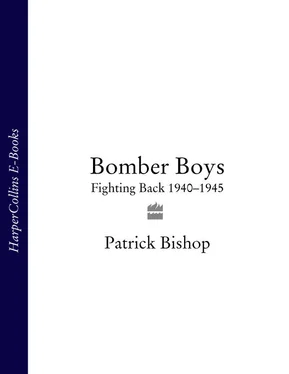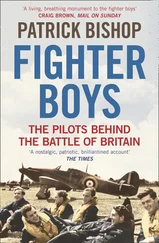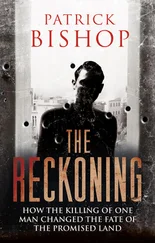By the end of 1940, then, the push of the war and the pull of the air was driving tens of thousands of young men towards Bomber Command. They were rich, middling and poor and they came from every corner of Britain and its empire. They were the best of their generation and they were heading for one of the worst tasks of the war.
The process by which these disparate and largely unskilled young men were moulded into effective members of a bomber crew was one of the great achievements of the wartime RAF. It was thorough, on the whole efficient, and surprisingly imaginative, qualities which seemed quite out of keeping with the prevailing pre-war service ethos of myopia and conservatism. Noble Frankland, who had joined the University Air Squadron on going up to Oxford in 1941 and went on to join Bomber Command and co-write the official history of its war, reckoned that by the end of operational training ‘most crews [had] a reasonable basis upon which to test their fortunes and their courage.’ 1The instruction period certainly lasted long enough. Ken Newman, who volunteered in May 1941 and was selected for pilot training, did not fly his first operational mission until the spring of 1944. A gap of about two and a half years between joining up and going into battle became the norm.
The strategic air campaign was, essentially, made up as it went along. Circumstances changed rapidly in the early days and it was some time before a regularized training programme evolved. With the coming of the four-engined heavies, the Stirlings, Lancasters and Halifaxes, the system settled down to produce a continuous stream of competent and well-prepared airmen.
The long journey to an operational squadron began with a visit to the RAF local recruiting station. Applicants were given a medical, an academic test and a brief interview after which the most obviously unsuitable were weeded out. Volunteers were applying simply to join the RAF and had no idea in which branch of the service they would end up. In the early stages, many dreamed of becoming fighter pilots. But by the end of 1940 Fighter Command’s hour had passed. The air war now belonged to Bomber Command and it was there that most volunteers would be sent. Even while the Battle of Britain was at its height, Churchill told the Cabinet and the Chiefs of Staff that ‘the fighters are our salvation, but the bombers alone provide the means of victory.’
Official propaganda emphasized their vital role. The first successful film of the war, Target for Tonight , which came out in July 1941, was a drama-documentary which used no actors, only RAF personnel who played themselves. It followed the crew of a Wellington, F for Freddie, preparing and executing a typical raid on a typical target in Germany, piloted by Charles ‘Percy’ Pickard, a blond, impassive, pipe-smoking paradigm of the pre-war RAF. The flying scenes, although spliced with authentic footage, look amateurish and unreal now and the airmen act their parts with a touching diligence but an almost total absence of technique. It was nonetheless a wild commercial success and was seen by audiences all around the free world.
Recruiting posters portrayed the crews as gallant and spirited, the natural successors to the Fighter Boys. Noble Frankland needed little convincing that Bomber Command was the place to be. ‘I thought that the defence of Great Britain was over and the next step was to smash the Germans up. I was quite keen to take part in smashing up the Germans, which I think was a fairly common sort of instinct, but I actually had an opportunity to do it.’ 2
As the war progressed, it became clear that bombing was drudge work, tedious and repetitive, and with the added disadvantage of being highly dangerous. Some volunteers who were chosen to fly were dismayed when they heard what it was that they would be flying. Dennis Field had done his initial instruction on single-engined Harvards and was looking forward to going on to fighters. As he moved to the next stage of his training ‘a special parade was called and the CO announced that the whole course would be trained for multi-engined aircraft and, we inferred, four-engined bombers. I felt totally deflated at the news. The very little I knew about them gave the impression that I should become a glorified bus-driver.’ 3
For Harry Yates, the ex-clerk who had worried that he was too humble for the RAF, distaste for the grim, mechanical nature of the work over-rode appeals to duty. In early 1943, after a spell serving as an instructor, he decided that he wanted to go to the front line of the air war. ‘My expectations were quite specific and they were high: night fighting in Mosquitoes or Beaufighters or, failing that, ground-strafing in Beaufighters. Flying a bomber didn’t figure anywhere. Indeed the whole point was to avoid it.’ The RAF’s priorities dictated otherwise and he was sent to Bomber Command. 4
At the beginning of the war Bomber Command’s most pressing need was for pilots. As aircraft grew in size and complexity, its requirements became much broader. The bombers in service in the early period contained an assortment of crews. The Whitley and the Wellington carried five men, including two pilots. The cramped and narrow body of the Hampden held four and had room for only one pilot. All types had an observer who acted as both navigator and bomb-aimer as well as a wireless operator and one or two gunners. The observer role was eventually split into the separate categories of navigator and bomb-aimer.
In August 1940 the first of the new generation of bombers began to appear, starting with the Stirling and followed by the Halifax and then the Lancaster, which by the end of the war was flown by 75 per cent of Bomber Command squadrons. It had been decided late in 1941 that a second pilot was superfluous. He rarely gained any flying experience and was little more than a passenger. Second pilots were dropped and replaced by flight engineers, highly trained technicians who monitored the running of the aircraft during flight. This was an important decision. Pilot training took longer and cost more than the other aircrew roles. With only a single pilot needed, more aircraft could be put in the air. If the practice of using two pilots had persisted, the great raids of 1942 that announced the opening of the main offensive would not have been possible.
By spring of 1942 there were six aircrew jobs for which volunteers could be considered: pilot, navigator, engineer, bomb-aimer, wireless operator and air gunner, of which there were two. After the initial vetting stage candidates were sent to an Aircrew Selection Centre. On the first day they faced a fairly demanding set of academic tests which were marked on the spot and the failures sent home. The following morning there was a rigorous medical. To pass ‘Aircrew A1’ required a higher level of fitness than was demanded by the other services. Next came an interview, typically by a panel of three senior officers. Dennis Steiner, a confectioner’s son from Wimbledon, who passed through the Oxford selection centre in August 1941, found it ‘more of a friendly chat than an interview. I knew that I had been accepted when it was remarked that I would like flying. As I left the room one called out “good luck lad”.’ 5Successful candidates were sworn in, issued with their RAF number and then, anti-climactically, told to go home and wait to be summoned. This period of ‘deferred service’ could last many months.
Eventually they were called to an Air Crew Reception Centre where basic training began. The newcomers marched, saluted, went on endless runs and listened to hair-raising lectures from the medical officer. These, wrote James Hampton, who was the youngest of three brothers who volunteered for aircrew and the only one to survive, warned the new arrivals, virgins almost to a man, about ‘some of the shocking and terrifying diseases that abounded and of which they had previously been unaware. These diseases had certain things in common. They could not be caught from lavatory seats and they invariably ended with General Paralysis of the Insane followed shortly by death.’ 6Venereal diseases were a service obsession. At his training centre in Babbacombe near Torquay, Brian Frow’s sheltered, middle-class innocence was shaken by lectures given at ‘great length, complete with slides lurid enough to frighten even the bravest from casual intercourse for life.’ 7
Читать дальше












